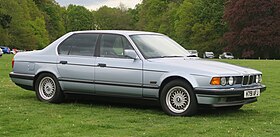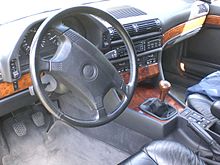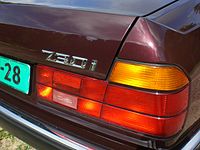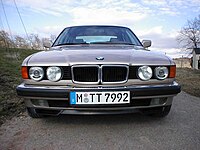| BMW 7 Series (E32) | |
|---|---|
 730i 730i | |
| Overview | |
| Manufacturer | BMW |
| Production | June 1986–April 1994 |
| Model years | 1987–1994 |
| Assembly | Germany: Dingolfing |
| Designer |
|
| Body and chassis | |
| Class | Full-size luxury car (F) |
| Body style | 4-door sedan/saloon |
| Layout | Longitudinal front-engine, rear-wheel-drive |
| Related | Alpina B12 |
| Powertrain | |
| Engine | |
| Transmission |
|
| Dimensions | |
| Wheelbase | SWB: 2,833 mm (111.5 in) LWB: 2,947 mm (116.0 in) |
| Length | SWB: 4,910 mm (193.3 in) LWB: 5,029 mm (198.0 in) |
| Width | 1,845 mm (72.6 in) |
| Height | SWB: 1,400 mm (55.1 in) LWB: 1,435 mm (56.5 in) |
| Curb weight | 1,720–1,930 kg (3,792–4,255 lb) |
| Chronology | |
| Predecessor | BMW 7 Series (E23) |
| Successor | BMW 7 Series (E38) |
The BMW E32 is the second generation of the BMW 7 Series luxury cars and was produced from 1986 until 1994. It replaced the E23 and was initially available with straight-six or V12 powerplants. In 1992, V8 engines became available. From its inception, the E32 was among the most technologically advanced cars in its day.
The E32 introduced numerous features including adaptive suspension (EDC), traction control, two available wheelbases (i and iL), and dual-zone climate control. The E32 750i was the first car adhering to "gentlemen's agreement" amongst the German manufacturers limiting maximum speed to 250 km/h (155 mph).
Other automotive passenger vehicles features introduced with the E32 included: projector lens headlamps (1986); double glazing windows (1991); HID (Xenon) headlamps (1991).
E32 also introduced BMW's first V8 engine since the BMW 501/502, last produced in 1962, and their first V12 engine, which was also Germany's first post-war V12 engine for a passenger vehicle.
In 1994, the E32 was replaced by the E38, a clear evolution of the E32.
Development and production
Styling was by chief stylist Ercole Spada and Hans Kerschbaum working under chief designer Claus Luthe. Design work began in late 1979. By 1983, 1:1 scale models were presented and frozen in October 1984 for production which was scheduled in June 1986. In a later interview with then BMW chief engineer Wolfgang Reitzle, it was revealed that a last minute decision was taken to widen the car by 40mm in order to improve its stance, and to develop a V12 engine, which would give the new 7-series a competitive advantage over the Mercedes S-Class. Reitzle persuaded BMW management, despite the fact that press tooling for the bodyshell had already been manufactured, and scrapping it would cost an estimated DM300million, and would push out the car's release date by a year.
Production of the E32 7 series started with the 735i in June 1986 and the 730i in December 1986, concluding in April 1994 with a total of 311,068 units built.
Features

Some luxury options featured on the E32 include integrated telephone and fax machines, a wine cooler, electronically adjustable rear seats and radio controls for rear passengers (exclusive to the 750iL).
In 1991, first series-production low beam Xenon high-intensity discharge headlamps (Litronic, only low beam) were introduced on the 750iL. Other safety features include a system that automatically increased spring pressure on the windscreen wipers to keep them firmly pressed on the glass at Motorway speeds.
The E32 was the first BMW available with traction control (marketed as Automatic Stability Control, though not considered stability control by more modern standards). Initial versions of ASC reduced wheelspin by reducing engine power, while later versions (ASC+T) also applied the rear brakes.
The E32 was also available in a long-wheelbase version (indicated by an 'L' from German Lang, after the model number) with an extra 11.4 cm (4.5 in) of rear leg room..
Engines


Over its lifespan, the E32 7 Series was produced with straight-six, V8 and V12 gasoline engines.
The launch models consisted of the 730i/iL and 735i/iL, which were powered by the M30 straight-six engine. Also available at the E32 launch was the 750i/iL, which was the first BMW ever sold with a V12 engine. The rated power output of the 5.0 L (305 cu in) M70 V12 is 220 kW (295 hp).
In 1991, BMW began production of its first V8 engine since the end of BMW 501/502 production in 1962. This M60 V8 was introduced in the E32, along with the E34 5 Series. The 4.0 litre version powered the new 740i/iL models, and the 3.0 litre version was sold in parallel with the M30 straight-six in the 730i/iL models. The top speed of the 740i was electronically limited to 240 km/h (149 mph). Both V8 engines were coupled to a new, 5-speed automatic transmission made by ZF. The Nikasil bore lining used in the M60 engine was prone to damage when used with high-sulfur fuels.
Styling
The E32 was the first BMW to use L-shaped tail-lights, which were designed with safety of following traffic in mind. Other styling features include a Hofmeister kink in the rear window line and circular headlights.
A narrow 'kidney' grille correlated with 6-cylinder models, and a wider grille was standard for V8 and V12 models. The narrow grille was not available as an option on the 8- and 12-cylinder E32 models.
Models
The official specifications are as follows.
| Model | Engine | Power | Torque | 0–100 km/h acceleration |
Top Speed | Years |
|---|---|---|---|---|---|---|
| 730i | M30B30 I6 |
135 kW (184 PS; 181 hp) at 5,800 rpm |
260 N⋅m (192 lb⋅ft) at 4,000 rpm |
10.8 (AT) 9.4 (MT) |
212 km/h (132 mph) (AT) 222 km/h (138 mph) (MT) |
1986–1987 |
| 138 kW (188 PS; 185 hp) at 5,800 rpm |
1987–1994 | |||||
| 145 kW (197 PS; 194 hp)* at 5,800 rpm |
275 N⋅m (203 lb⋅ft)* at 4,000 rpm |
10.6 (AT) 9.3 (MT) |
225 km/h (140 mph) (AT) 230 km/h (143 mph) (MT) |
1986–1992 | ||
| 730i | M60B30 V8 |
160 kW (218 PS; 215 hp) at 5,800 rpm |
290 N⋅m (214 lb⋅ft) at 4,500 rpm |
9.3 (AT) 8.5 (MT) |
230 km/h (143 mph) (AT) 233 km/h (145 mph) (MT) |
1992–1994 |
| 735i | M30B35 I6 |
155 kW (211 PS; 208 hp) at 5,700 rpm |
305 N⋅m (225 lb⋅ft) at 4,000 rpm |
9.1 (AT) 8.3 (MT) |
225 km/h (140 mph) (AT) 232 km/h (144 mph) (MT) |
1986–1992 |
| 162 kW (220 PS; 217 hp)* at 5,800 rpm |
315 N⋅m (232 lb⋅ft)* at 4,000 rpm |
9.0 (AT) 8.2 (MT) |
227 km/h (141 mph) (AT) 235 km/h (146 mph) (MT) | |||
| 740i | M60B40 V8 |
210 kW (286 PS; 282 hp) at 5,800 rpm |
400 N⋅m (295 lb⋅ft) at 4,500 rpm |
7.4 (AT) | 240 km/h (149 mph)** | 1992–1994 |
| 750i | M70B50 V12 |
220 kW (300 PS; 296 hp) at 5,200 rpm |
450 N⋅m (332 lb⋅ft) at 4,100 rpm |
7.4 (AT) | 250 km/h (155 mph)** | 1987–1994 |
* uncatalyzed
** Electronically limited top speed
Alpina models

The Alpina B11 3.5 is based on the E32 735i and introduced in 1987 with a 187 kW (254 PS; 251 hp) inline-six engine. Between 1987 and 1993 a total of 332 cars were produced.
The Alpina B11 4.0 is based on the E32 740i with a modified engine producing 232 kW (315 PS; 311 hp) (compared with 210 kW (286 PS; 282 hp) for the 740i) and 410 N⋅m (302 lb⋅ft) of torque. Just 7 cars were made in 1993 and 1994.
The Alpina B12 5.0 is based on the E32 750i/750iL and used a modified V12 engine producing 257 kW (350 PS; 345 hp) (compared with 220 kW (299 PS; 295 hp) for the 750i/750iL) and 470 N⋅m (347 lb⋅ft) of torque. A total of 305 cars were made.
Special models
750iL Highline
The BMW 750iL Highline was the top-of-the-line model of the E32, with lots of added luxury for the rear passengers like full leather seats, dual radio controls, dual climate control with coolbox mounted in the center console, electrically heated and adjustable rear seats, walnut veneer folding tables, two crystal glasses neatly placed in the coolbox, leg rests, and electronically operated sun shades all around the rear/side windows. Complete with independent heating and ventilation, it also added a second battery in the trunk and a second alternator to provide power for all these luxuries. The 'Highline' option package cost more than 20,000 DM, and was only available on the 750iL, bringing the total price to well over twice that of a base model 730i.
Goldfisch prototype
Main article: BMW Goldfisch V16The Goldfisch, also called the 767 or the "Secret Seven" internally, is a concept full size luxury car based on the E32 750i. Conceived by Dr. Karlheinz Lange in the late 1980s, it was meant to be the top-of-the line variant of the 7 Series also designed to compete with offerings from rival Mercedes-Benz. Dr. Lange also involved two other employees in the project, namely Adolf Fischer and Hanns-Peter Weisbarth both being senior employees. The concept car was completed in just six months. The main notable feature is the V16 engine designed by Adolf Fischer, which is essentially a modified M70 V12 enlarged to have four extra cylinders, capacity enlarged to 6.7-litres, etched iron pistons, nine-bearing crankshaft and having silicone-aluminium casting. The engine was fitted with Bosch DME 3.3 engine management system for better performance. Desired level of performance was achieved when the system treated the engine as two inline-8 engines bolted together. The resulting engine had a power output of 414 PS (304 kW; 408 hp) and 625 N⋅m (461 lb⋅ft) of torque. Power was sent to the rear wheels via a 6-speed manual transmission shared with the E31 8 Series. The car had the engine cooling system located in the boot along with fabricated fibre glass gills and air scoops at the rear to aid in cooling as there was no space to accommodate them at the front as the resulting engine was 305 mm (12 in) longer than the V12 engine. Air was expelled through a custom made valence panel at the rear of the car which led to the use of small tail lights with no fog and reverse lights. Despite the usage of a large V16 engine, the car was only 60 kg (132 lb) heavier than the 750i. The Goldfisch could accelerate to 100 km/h (62 mph) in a claimed 6 seconds and could attain a top speed of 282 km/h (175 mph). The car remained a technology demonstrator only and was never put into production due to the V16 engine being incompliant to the environmental regulations.
Related cars
The E34 5 Series, introduced in 1988, has exterior design almost identical to the E32. It also uses the same M30 straight-6 and M60 V8 engines, and several other parts.
The E31 8 Series, introduced in 1989, uses the same M60 V8 and M70 V12 engines as the E32.
References
- Oswald, Werner (2001). Deutsche Autos 1945–1990, Band 4 (1. ed.). Stuttgart: Motorbuch Verlag. ISBN 3-613-02131-5.
- Kittler, Eberhard (2001). Deutsche Autos seit 1990, Band 5 (1. ed.). Stuttgart: Motorbuch Verlag. ISBN 3-613-02128-5.
- (BMW Plant Dingolfing)"Vehicle manufacturer profiles". www.automotiveworld.com. Retrieved 2011-09-24.
- "Homage to Claus Luthe". www.kulturgut-mobilitaet.de (in German). Retrieved 10 March 2017.
- ^ "1986 BMW 730i Automatic E32". www.carfolio.com. 2008-04-03. Retrieved 2011-09-24.
- ^ "1987 BMW 750iL E32". www.carfolio.com. 2008-04-03. Retrieved 2011-09-24.
- ^ "Retro drives: BMW E32 and E38 V12 7 Series". www.carenthusiast.com. Retrieved 8 March 2017.
- "E32 – The Second Generation BMW 7 Series". www.bmwblog.com. Archived from the original on 21 March 2019. Retrieved 8 March 2017.
- "1986 BMW 735i E32 7-Series - giant road test". www.drive-my.com. 27 November 2015. Retrieved 31 March 2017.
- "BMW 7 Series (E32)". www.autoevolution.com. Retrieved 8 March 2017.
- ^ "BMW E32 specs, speed & engine review". www.thesupercars.org. 15 July 2006. Retrieved 8 March 2017.
- "BMW Car Designers". www.bmwism.com. Archived from the original on 18 October 2012. Retrieved 26 July 2012.
- "BMW Remembers the Second-Generation 7-Series E32". www.carscoops.com. 2 September 2013. Retrieved 31 March 2017.
- https://archive.org/stream/BMWThe7SeriesProject/BMW%20The%207-Series%20Project_djvu.txt
- "BMW Classic - Recherche-Client".
- "BMW Classic - Recherche-Client".
- Behrend, Jürgen. Hella 1899-1999. p. 97.
- Neumann, Rainer; Woerner, B. (1993). "Litronic – New Automotive Headlamp Technology with Gas Discharge Lamp". Automotive Design Engineering: 152–156.
- "BMW TIS - Automatic Stability Control with Traction Control System" (PDF). www.steerbythrottle.com. Retrieved 30 July 2017.
- "Vollkommen neu: Completely New: The Second Generation Of The BMW 7 Series" (PDF). www.bmw-grouparchiv.de. Retrieved 21 August 2017.
- BMW V-12 Light Alloy Engine M70. P. 5. June 1987
- BMW M60B40 Automobilmotor
- "BMW 730i 6-cyl. (E32)". bmw-grouparchiv.de. Retrieved 14 August 2019.
- ^ Betriebsanleitung BMW E32. p. 121. 1992
- "BMW 7 Series: The second generation E32". BMW YouTube Channel. Archived from the original on 2021-12-22. Retrieved 30 March 2013.
- Die zweite Generation der BMW 7er-Reihe. P. 5. 1987
- "BMW E32 735". www.carfolio.com. 2008-04-03. Retrieved 2010-11-06.
- "BMW E32 730 V8". www.carfolio.com. 2008-04-03. Retrieved 2010-11-06.
- "BMW E32 740". www.carfolio.com. 2008-04-03. Retrieved 2010-11-06.
- "BMW 7 Series E32: ALPINA Automobiles". www.alpina-automobiles.com. Retrieved 10 July 2021.
- ^ Büschi, Hans-Ulrich, ed. (5 March 1992), Automobil Revue 1992 (in German and French), vol. 87, Berne, Switzerland: Hallwag AG, p. 101, ISBN 3-444-00539-3
- "BMW 7 Series E32: ALPINA Automobiles". www.alpina-automobiles.com. Retrieved 10 July 2021.
- Åhman, Michael, ed. (1993), Bilkatalogen 1994 (Swedish edition of German Auto Katalog) (in Swedish), Borlänge, Sweden: Bilkatalogen AB, p. 206
- "BMW 7 Series E32: ALPINA Automobiles". www.alpina-automobiles.com. Retrieved 10 July 2021.
- "BMW 7er, Modell E32, Sonder-Ausstattungsdetails inkl. Preisen". www.7-forum.com. 2006-06-03. Retrieved 2009-09-26.
- Daradics, Csaba (2010-10-16). "BMW's 767: The Golden Fish That Got Away". Jalopnik. Retrieved 2019-03-31.
- Babs, Joey (2009-11-02). "BMW's Secret 7 Series model: E32 Prototype with 6.7L V16 engine". BMW-blog. Archived from the original on July 29, 2012. Retrieved 2019-03-31.
| « previous — BMW cars: 1960s to 1980s — next » | ||||||||||||||||||||||||||||||||||||||||||||||||||||||||||||||||||||||||||||||||||||||||||||||||||||||||||||||||||||||||||||||||||||||||||||||||||||||||||||||||||||||||||||||||||||||||||||||||||||||||||||||||||||||||||||||||||||||||||||||||||||||||||||||||||||||||||||||||||||||||||||||||||||||||||||||||||||||||||||||||||||||||||||||||||||||||||||||||||||||||||||||||||||||||||||||||||||||||||||||||||||||||||||||
|---|---|---|---|---|---|---|---|---|---|---|---|---|---|---|---|---|---|---|---|---|---|---|---|---|---|---|---|---|---|---|---|---|---|---|---|---|---|---|---|---|---|---|---|---|---|---|---|---|---|---|---|---|---|---|---|---|---|---|---|---|---|---|---|---|---|---|---|---|---|---|---|---|---|---|---|---|---|---|---|---|---|---|---|---|---|---|---|---|---|---|---|---|---|---|---|---|---|---|---|---|---|---|---|---|---|---|---|---|---|---|---|---|---|---|---|---|---|---|---|---|---|---|---|---|---|---|---|---|---|---|---|---|---|---|---|---|---|---|---|---|---|---|---|---|---|---|---|---|---|---|---|---|---|---|---|---|---|---|---|---|---|---|---|---|---|---|---|---|---|---|---|---|---|---|---|---|---|---|---|---|---|---|---|---|---|---|---|---|---|---|---|---|---|---|---|---|---|---|---|---|---|---|---|---|---|---|---|---|---|---|---|---|---|---|---|---|---|---|---|---|---|---|---|---|---|---|---|---|---|---|---|---|---|---|---|---|---|---|---|---|---|---|---|---|---|---|---|---|---|---|---|---|---|---|---|---|---|---|---|---|---|---|---|---|---|---|---|---|---|---|---|---|---|---|---|---|---|---|---|---|---|---|---|---|---|---|---|---|---|---|---|---|---|---|---|---|---|---|---|---|---|---|---|---|---|---|---|---|---|---|---|---|---|---|---|---|---|---|---|---|---|---|---|---|---|---|---|---|---|---|---|---|---|---|---|---|---|---|---|---|---|---|---|---|---|---|---|---|---|---|---|---|---|---|---|---|---|---|---|---|---|---|---|---|---|---|---|---|---|---|---|---|---|---|---|---|---|---|---|---|---|---|---|---|---|---|---|---|---|---|---|---|---|---|---|---|---|---|---|---|---|---|---|---|---|---|---|---|---|---|---|---|---|---|
| ||||||||||||||||||||||||||||||||||||||||||||||||||||||||||||||||||||||||||||||||||||||||||||||||||||||||||||||||||||||||||||||||||||||||||||||||||||||||||||||||||||||||||||||||||||||||||||||||||||||||||||||||||||||||||||||||||||||||||||||||||||||||||||||||||||||||||||||||||||||||||||||||||||||||||||||||||||||||||||||||||||||||||||||||||||||||||||||||||||||||||||||||||||||||||||||||||||||||||||||||||||||||||||||
| « previous — BMW cars: 1980s to 2000s — next » | |||||||||||||||||||||||||||||||||||||||||||||||||||||||||||||||||||||||||||||||||||||||||||||||||||||||||||||||||||||||||||||||||||||||||||||||||||||||||||||||||||||||||||||||||||||||||||||||||||||||||||||||||||||||||||||||||||||||||||||||||||||||||||||||||||||||||||||||||||||||||||||||||||||||||||||||||||||
|---|---|---|---|---|---|---|---|---|---|---|---|---|---|---|---|---|---|---|---|---|---|---|---|---|---|---|---|---|---|---|---|---|---|---|---|---|---|---|---|---|---|---|---|---|---|---|---|---|---|---|---|---|---|---|---|---|---|---|---|---|---|---|---|---|---|---|---|---|---|---|---|---|---|---|---|---|---|---|---|---|---|---|---|---|---|---|---|---|---|---|---|---|---|---|---|---|---|---|---|---|---|---|---|---|---|---|---|---|---|---|---|---|---|---|---|---|---|---|---|---|---|---|---|---|---|---|---|---|---|---|---|---|---|---|---|---|---|---|---|---|---|---|---|---|---|---|---|---|---|---|---|---|---|---|---|---|---|---|---|---|---|---|---|---|---|---|---|---|---|---|---|---|---|---|---|---|---|---|---|---|---|---|---|---|---|---|---|---|---|---|---|---|---|---|---|---|---|---|---|---|---|---|---|---|---|---|---|---|---|---|---|---|---|---|---|---|---|---|---|---|---|---|---|---|---|---|---|---|---|---|---|---|---|---|---|---|---|---|---|---|---|---|---|---|---|---|---|---|---|---|---|---|---|---|---|---|---|---|---|---|---|---|---|---|---|---|---|---|---|---|---|---|---|---|---|---|---|---|---|---|---|---|---|---|---|---|---|---|---|---|---|---|---|---|---|---|---|---|---|---|---|---|---|---|---|---|---|---|---|
| |||||||||||||||||||||||||||||||||||||||||||||||||||||||||||||||||||||||||||||||||||||||||||||||||||||||||||||||||||||||||||||||||||||||||||||||||||||||||||||||||||||||||||||||||||||||||||||||||||||||||||||||||||||||||||||||||||||||||||||||||||||||||||||||||||||||||||||||||||||||||||||||||||||||||||||||||||||



